Herbaceous peonies: the best varieties, planting and care
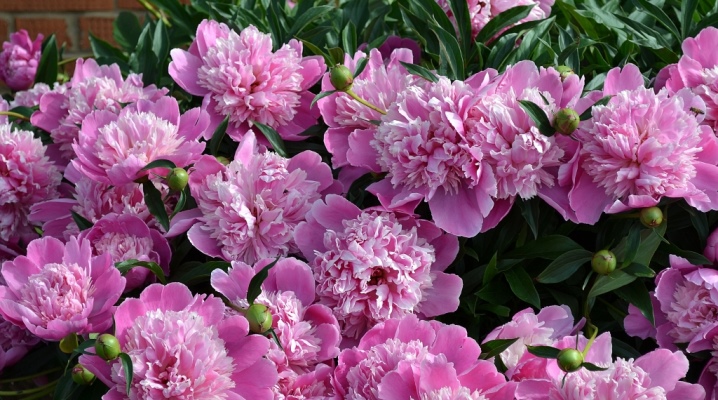
Herbaceous peonies are spectacular, flowering perennials that can decorate any garden plot. Experienced gardeners argue that there are no particular difficulties in growing these plants, so even a novice florist will be able to cope with them. What conditions are necessary for peonies for full development and growth? What are the nuances to consider when growing them? Let's try to figure it out.
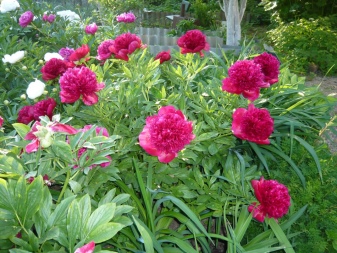

Peculiarities
The main difference between herbaceous peonies and tree peonies is that before the onset of cold weather, their aboveground part dies off. In the spring, when nature begins to wake up, the root system of the plant quickly forms a new large bush.
Herbaceous peonies include an extensive group of beautifully flowering perennials with powerful thickened roots that can reach almost a meter in length with age. Another characteristic feature of these plants is the very beautiful and unusually large flowers. It is noteworthy that as the peonies age, their flowers grow in size, reaching 20 or more centimeters. In addition, the number of flowers increases with age - so, on one mature bush, there can be up to 100 of them.
Peony flowers are characterized by a wide range of aromas. It is believed that the most fragrant are peonies with pink flowers. Depending on the type of plant, the aroma of its flowers can be fruity, citrus, vanilla, amber, musky.

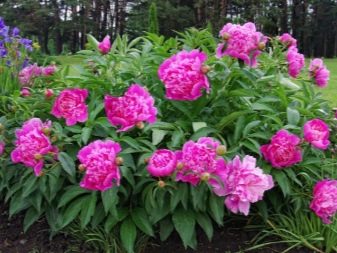
With proper care, the herbaceous peony bush can reach a height of 50-100 centimeters. Thanks to the dense and spreading shoots covered with large leaves, the bushes look proportional, symmetrical and quite voluminous. The impressive decorativeness of these plants has become one of the main reasons why herbaceous peonies have become widespread in landscape design.
Peonies do not lose their attractiveness after flowering. Their lush foliage retains its decorative effect until late autumn, often taking on a reddish purple or bronze brown hue.

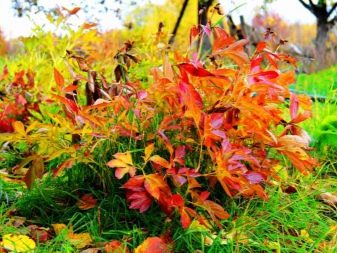
Being perennial plants, herbaceous peonies enter the flowering phase in the second, or, more often, in the third year. During the flowering period, plants form numerous and, as a rule, single flowers, the color and shape of which depend on varietal and hybrid characteristics.
The overwhelming majority of known hybrids and varieties were obtained by breeders from two original species - lacto-flowering and medicinal peonies. Both species are cultivated as ornamental plants for gardening and urban landscaping. To date, several hundred unique varieties have been obtained from the milk-flowered peony alone, including varieties with double flowers.
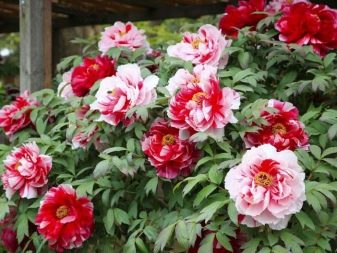
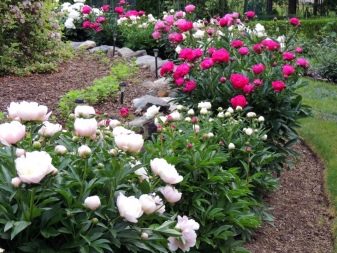
In crop production, these herbaceous ornamental perennials are classified according to the type of their flowers. So, taking into account this criterion, it is customary to distinguish between peonies with flowers of the following types:
- terry;
- semi-double;
- simple.
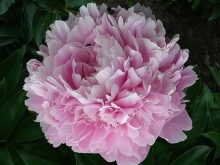
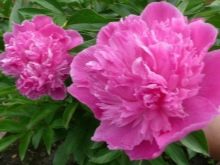

These flowering perennials are also classified according to the height of the aboveground part. Based on this characteristic, peonies are distinguished:
- undersized (up to 50 centimeters);
- medium-sized (50-90 centimeters);
- tall (over 90 centimeters).
It is customary to distinguish the varieties of peonies by the timing of flowering. So, in accordance with this characteristic, early flowering, medium and late flowering varieties are distinguished.


Varieties
According to historical sources, mankind has been engaged in the selection and creation of new varieties of peonies since ancient times. For example, in China, by the 6th century, about 30 varieties of these perennials were known. To date, the breeder has managed to obtain about 5 thousand different varieties of herbaceous peonies. Below are some of the best and most popular ones.
- Coral Sunset - varietal peony, notable for its spectacular appearance. The plant forms an erect, strong and compact bush, the height of which can reach 100-110 centimeters. Moreover, the diameter of the crown can vary from 80 to 90 centimeters. The leaves are emerald green, thick and large. During the flowering period, it forms many single double or semi-double flowers of pinkish-peach color with a dark yellow core.
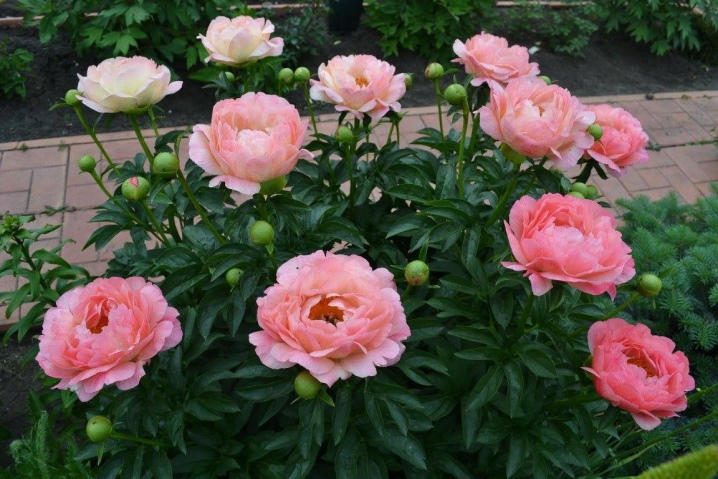
- Sorbet - a variety that has gained wide popularity among gardeners. Its distinctive features are a strong and sturdy bush up to 90 centimeters high, lush foliage, large and very fragrant double flowers of pink-cream color. The variety is considered one of the most unpretentious in cultivation, resistant to cold and disease.
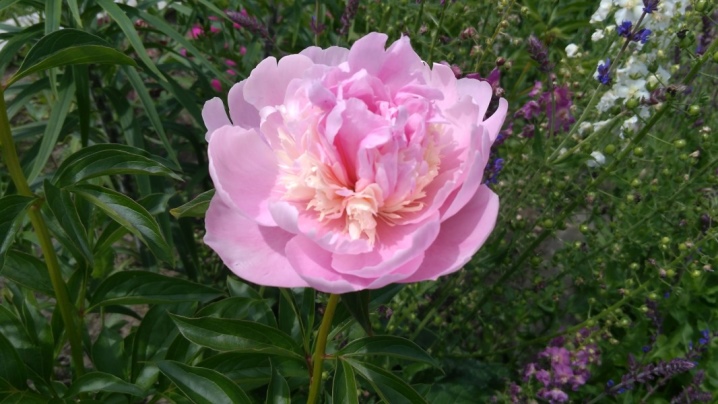
- Shirley Temple - an early flowering variety that forms large (up to 20 centimeters in diameter) double flowers of a snow-white color with a slight pinkish blush during the flowering period. The plant has strong and well-developed shoots that do not need a garter.
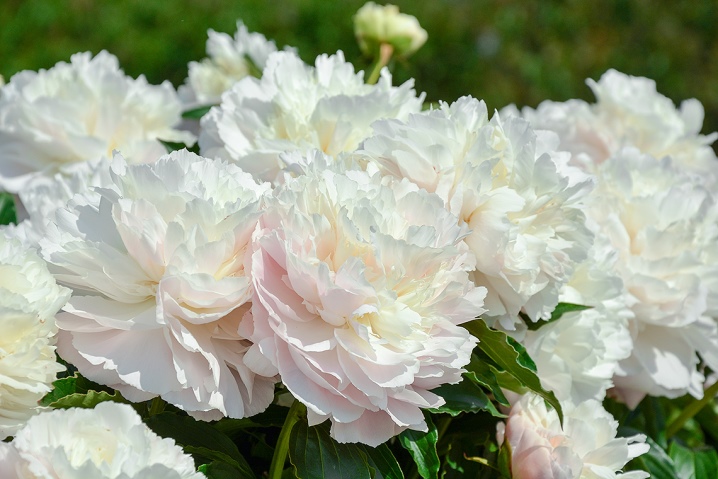
- "Yellow Crown" Is a very attractive variety that is popular with gardeners for its abundant and lush flowering. The plant forms a beautiful compact bush with carved soft green foliage, which effectively contrasts with yellow-lemon double flowers. The average diameter of flowers is 15 centimeters.
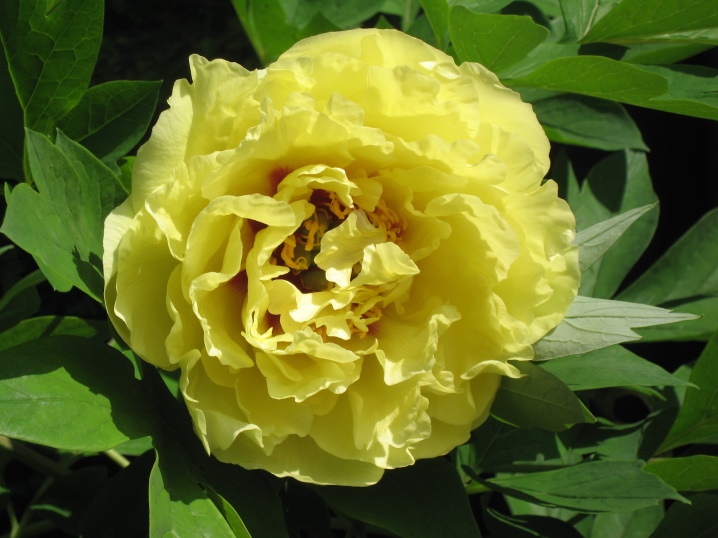
- "Primavera" - a cold-resistant variety, appreciated by gardeners for its impressive decorative effect. Forms a neat symmetrical bush up to 90 centimeters high. During the flowering period, it forms anemone-shaped flowers of the original color. The outer petals are white in color, the central ones are lemon yellow.

- Sarah Bernhardt - a fairly old and well-known variety that is widely used in landscape design. The plant is remarkable for its abundant and generous flowering, during which it forms many dense and voluminous flowers of white-pink color with a pleasant aroma.

- Dinner Plate - terry variety of medium late flowering time. Forms a strong and neat shrub with strong and well-developed stems. The flowers are fragrant, spherical, deep pink in color.
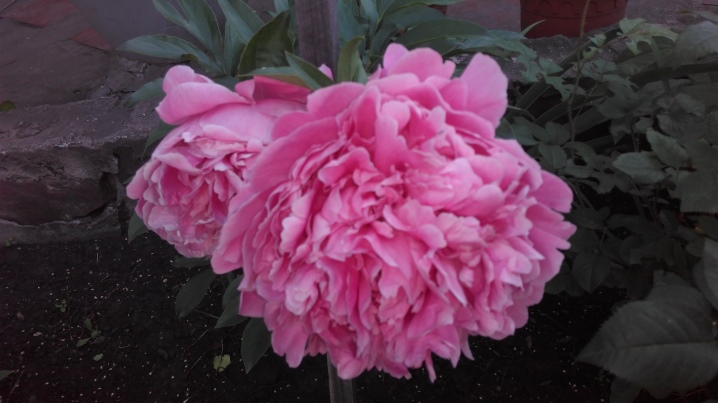
- "Coral charm" - a tall variety of peony, forming a bush up to 100-110 centimeters high. The flowers are large (18-20 centimeters in diameter), semi-double, bright coral color with a rich yellow center. The petals are concave, with smooth arcuate or serrated edges.
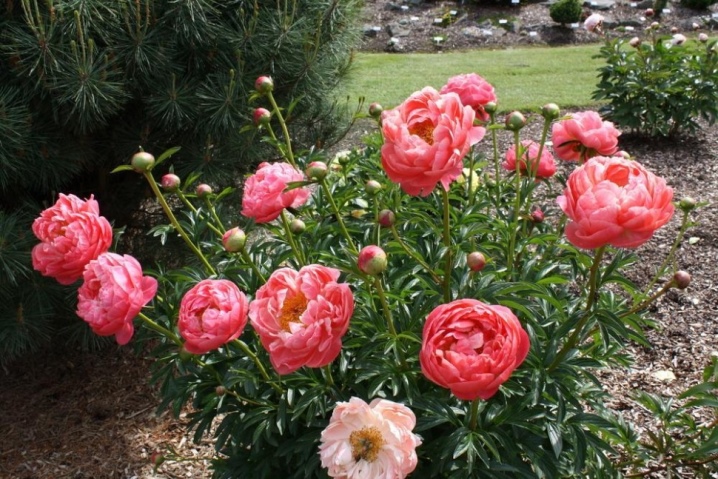
- "Bowl of beauty" - a profusely flowering variety that has won the love of gardeners for its amazing decorativeness. The plant is remarkable for the unusual color of anemone flowers with purple-pink outer petals and a bright yellow core. The bush is compact and symmetrical, reaching a height of 90 centimeters.
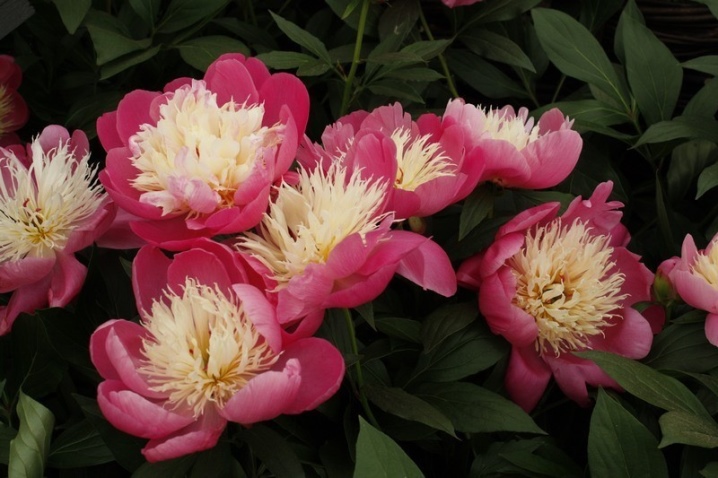
- "Peter Brand" - one of the most spectacular varieties of red peonies. The average plant height is 85-90 centimeters. Flowers - large, semi-double, juicy ruby color with a rich yellow center.
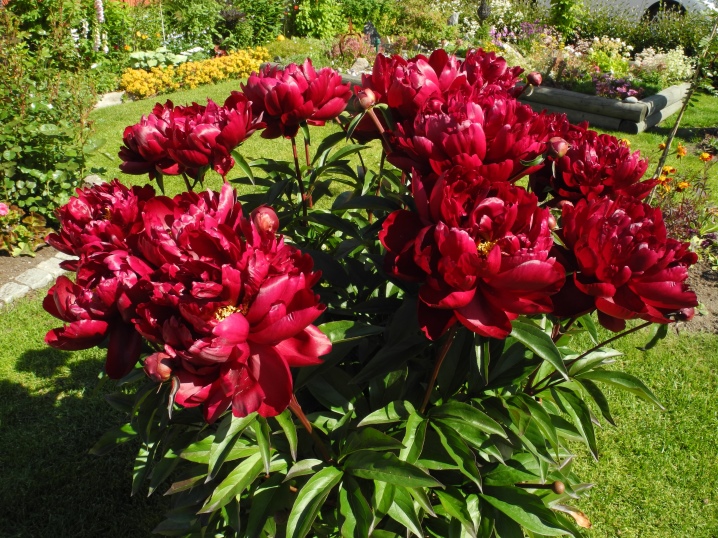
- "Buckeye Bell" - a medium-sized variety that forms a compact bush about 80 centimeters high. The plant looks very impressive during the flowering period. At this time, the peony forms numerous bright burgundy lush flowers, which contrast favorably with the dark emerald leaves of an elongated shape.
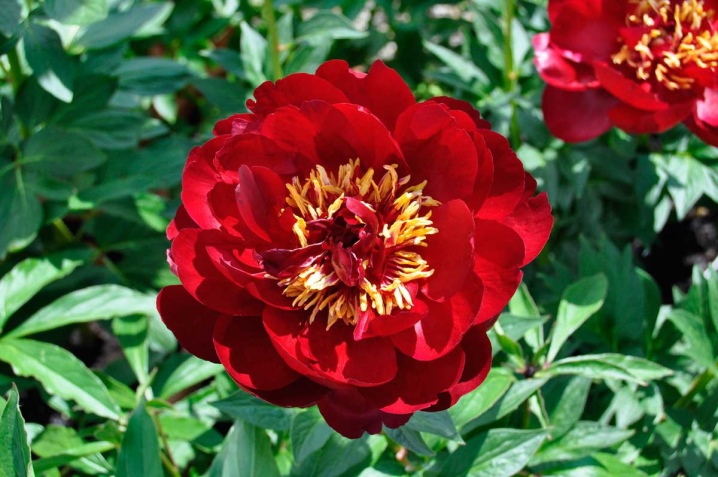
- "Kansas" - flowering varietal peony, valued for its unpretentiousness, cold resistance and attractive appearance. During the flowering period, the plant is covered with large double flowers of a deep pink color with a lilac tint. It blooms profusely, forming about 15-20 inflorescences on one bush. The number of flowers and their sizes depend on the age of the plant.

- "Red Magic" - a luxurious variety with large double flowers in red tones. The palette of shades ranges from deep burgundy to cranberry-wine. Thick feathery and rounded petals give the flowers a voluminous spherical shape. The variety is very decorative, cold-resistant, resistant to a wide range of diseases.
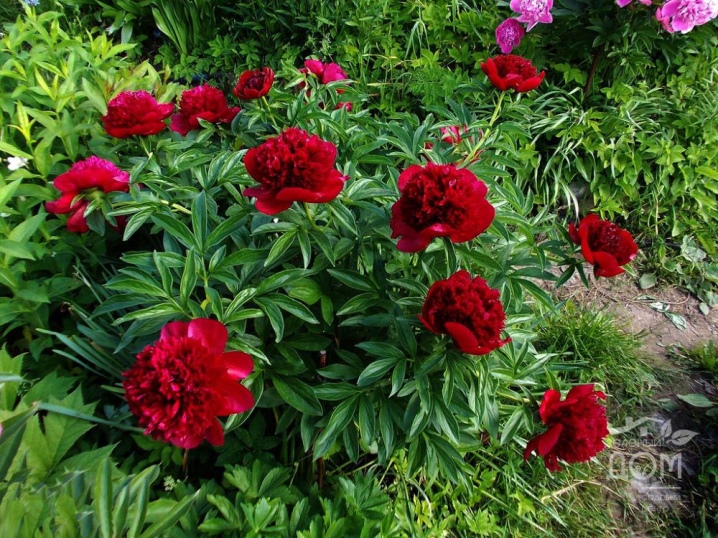
- "Pink Hawaiian Coral" Is a very famous and popular variety, bred by American breeders. The plant forms a beautiful bush up to 90 centimeters high. The leaves have an elongated shape and a uniform dark green color. Flowers are medium in size (about 15 centimeters in diameter), a juicy coral-pink shade, thickening at the edges of the petals, and a bright yellow core.
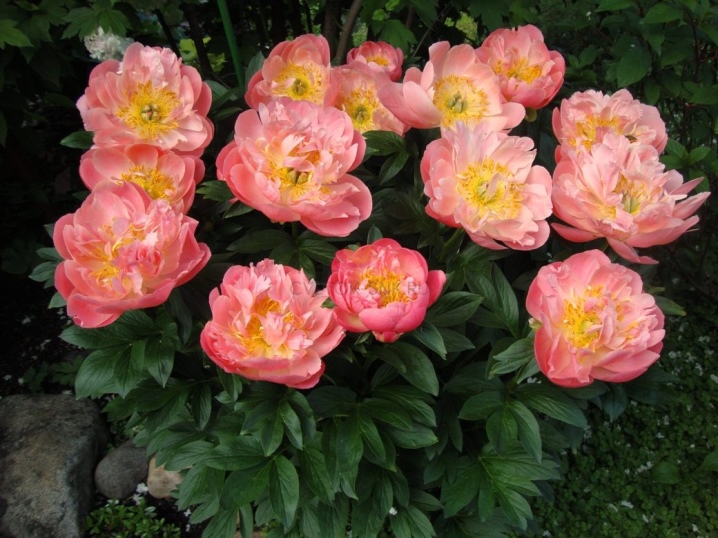
- "Laura dessert" - a tall variety used for both group and single plantings. Forms a strong and strong shrub with long sturdy stems. The flowers are medium-sized (14-15 centimeters in diameter), double, very fragrant, pink-yellowish in color.
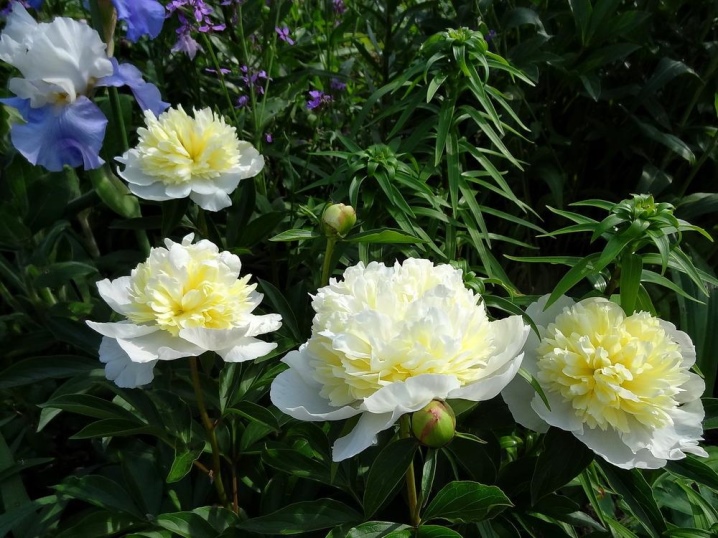
- Karl Rosenfeld - one of the brightest and most spectacular varieties of purple-red peonies. A mature bush can reach about 95 centimeters in height, has strong and durable stems, thick elongated leaves. Forms double globular flowers, the color of which can vary from ruby red to purple and crimson hues. It begins to bloom intensively about 3-4 years after planting.
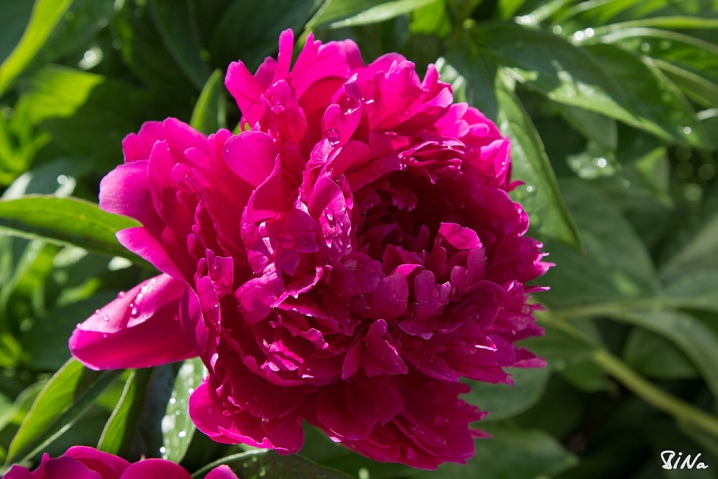
- "Top Brass" - a luxurious variety that is widely used in landscape design. The plant has a powerful and sturdy bush, reaching a height of 95-100 centimeters. During the flowering period, forms large (up to 18 centimeters) and voluminous double flowers. The outer petals have a pale milky color, smoothly turning into a pink-yellow hue in the center of the inflorescence. The variety is characterized by frost resistance, and therefore it perfectly takes root in difficult climatic conditions.

- Celebrity Is a fantastic bicolor variety, remarkable not only for its unusual color of flowers, but also for its intensive growth. The plant quickly enough forms a compact and symmetrical bush, the volume of which is given by openwork and slightly dissected foliage. Flowers - double, spherical, have an original pink-white color.
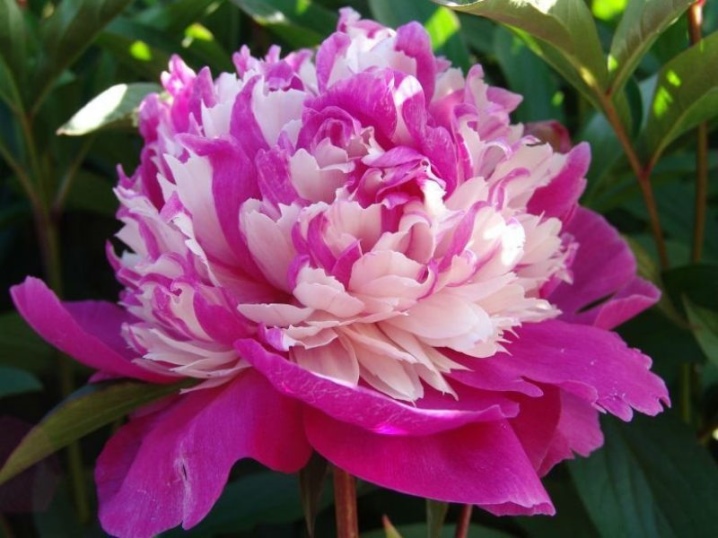
- "Cora stubbs" - a fairly well-known and old variety, recommended for growing in single and group plantings. It enters the flowering phase in May-June. During this period, the plant forms many double flowers, the outer petals of which are lilac-pink in color, and the inner part is pale cream.

- "White Crane" - a spectacular variety of mid-late flowering. The plant has a strong and well-developed bush, glossy green foliage and strong long stems. Flowers - large, double, piercing white. The height of a mature bush can reach 100 centimeters.
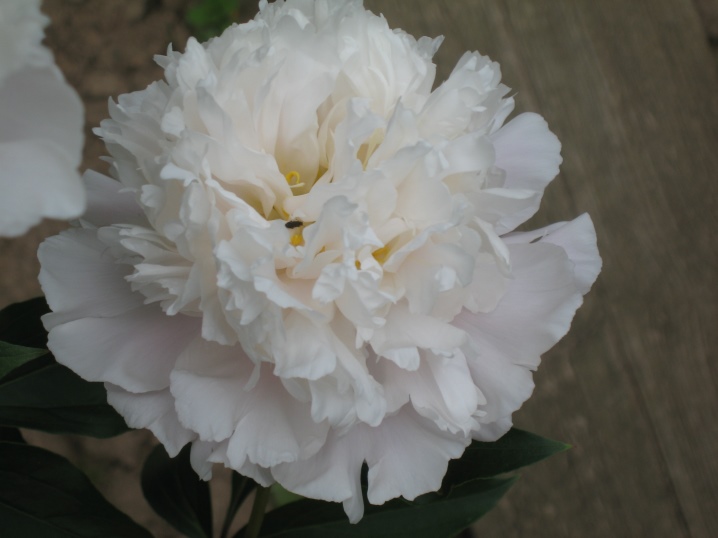
- "Golden halo" - a fast-growing variety, forming large and multi-layered double flowers of a noble ivory shade with a slight yellowness during the flowering period. The graceful and dense elongated foliage gives the plant a special decorative effect, making the bush more voluminous, airy and embossed.
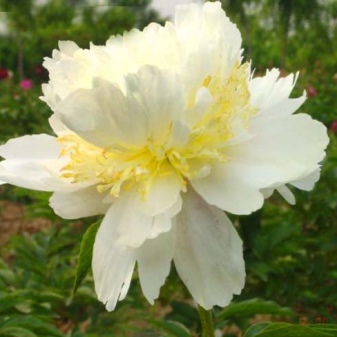
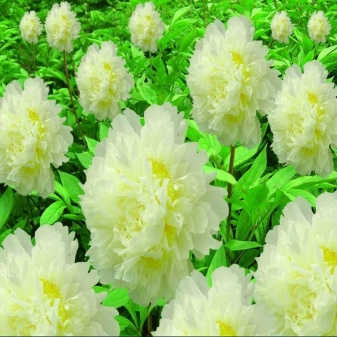
- "Prairie charm" - a very unusual hybrid with medium-sized semi-double flowers of exotic colors. The outer petals of this peony are pale yellow with a slight greenish tint, and the core is decorated with a purple ring.
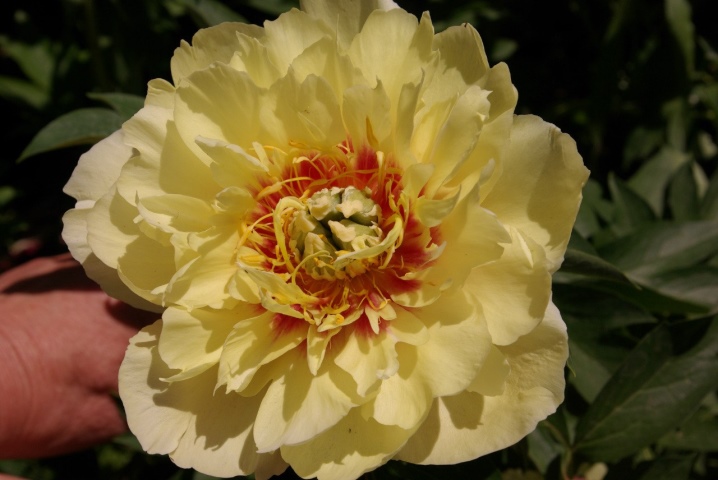
Growing conditions
In order for these delightful garden dwellers to feel great and regularly delight their owner with luxurious flowering, they need to create the most comfortable conditions. This assumes the fulfillment of requirements such as:
- the right choice of place;
- suitable soil composition;
- correct irrigation regime;
- timely feeding.
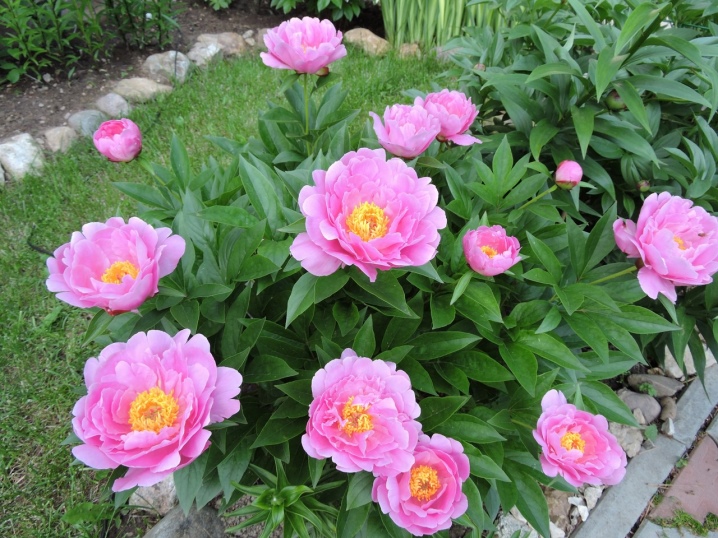
Seat selection
Most of these herbaceous perennials prefer sunny places, but they tolerate a little shade quite well during the height of a hot day. Lack of lighting negatively affects the state of peonies, leading to a reduction in the number and size of their flowers.
It is very important that the place where the peonies grow is protected from wind gusts and drafts that can harm the plants. You also need to make sure that this place is warm enough and warms up well during the day.
In addition, good air ventilation is important for peonies. They feel best in the fresh air, where they are provided with a constant supply of oxygen in the absence of pronounced drafts.
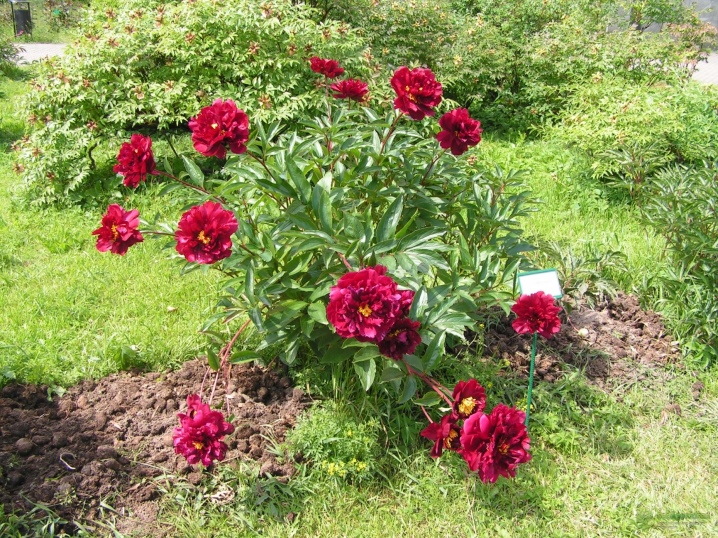
The soil
These perennials prefer to grow in areas where the soil has a slightly acidic or neutral reaction. Acidic soils are not suitable for peonies.
Loose, well-drained and fertile soil is optimal for these perennials.
It is important to note that areas with a high level of groundwater are not suitable for growing peonies. In such places, moisture regularly stagnates, which these flowers absolutely cannot stand.

Watering
Considering that peonies react painfully to excess moisture in the soil, they should be watered with great care. Experienced flower growers claim that in a moderately hot summer, these plants will only need two waterings: at the end of June and at the end of August.
In dry summers, flowers need to be watered more often, controlling the degree of soil moisture. Do not allow stagnation of water in the area with peonies, allowing the surface of the earth to dry out after the next watering.
In addition, timely watering during the period of bud formation, flowering and active development is also necessary for these plants. Experiencing a lack of moisture, peonies will begin to use their energy more economically, which will not have the best effect on their appearance, size and number of buds.

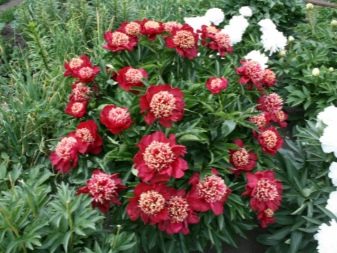
Top dressing
Considering that most varietal and hybrid herbaceous peonies are characterized by intense growth rates and generous flowering, it is very important to feed these plants in a timely manner. So, it is recommended to apply fertilizers under these beautifully flowering perennials three times a season at such stages as:
- entering the stage of intensive development;
- the stage of bud formation;
- flowering stage.
Some growers also feed peonies after they have faded. It is believed that this top dressing will allow plants to quickly recover the energy spent on stem growth and bud formation. For top dressing, both organic and mineral fertilizers are used.
It should be noted that the most important is the spring feeding, which activates the vital resources of the plant.
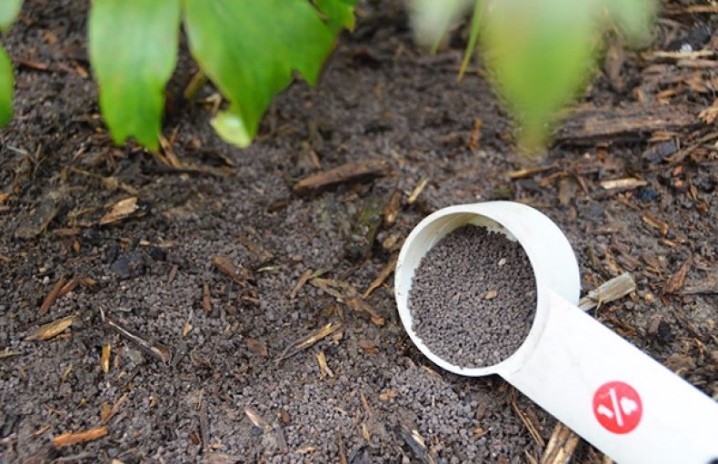
How to plant?
Intending to plant these beautifully flowering perennials in open ground in their area, they begin to prepare the soil a few weeks before the planned event. So, in areas with fertile soil, it will be quite thorough digging with the introduction of compost or humus.
If the land on the site does not correspond to the required parameters (looseness, fertility), you can correct the situation as follows:
- equip planting pits with dimensions of about 65x65x65 centimeters;
- mix the soil extracted from the planting pits with sand, peat, humus or compost, as well as a small amount of wood ash;
- add fertilizers based on phosphorus and potassium to the mixture;
- mix all components.
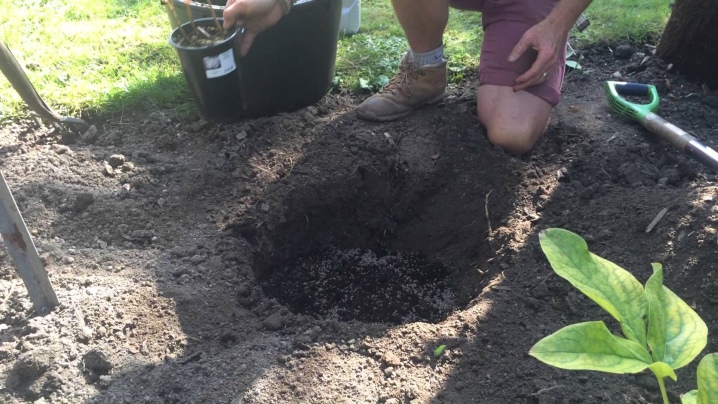
Before planting peonies, a drainage layer 10-20 centimeters thick is laid on the bottom of the prepared pits (the higher the groundwater level in the area, the thicker the drainage layer should be). Next, the pits are filled with the prepared soil mixture, laying it on top of the drainage layer. After completing this procedure, the pits are left for some time so that the earth in them has time to settle.
Peonies are planted very carefully so as not to damage the roots. The distance between the bushes should be at least one meter. Placing the plants in the pits, the soil is poured from the sides and around the bushes, slightly compacted and watered.
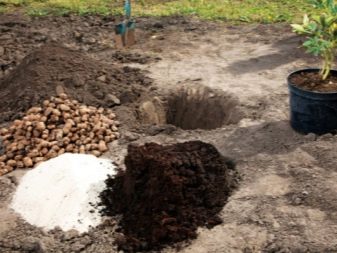

How to take care of it properly?
Peonies are important not only for sufficient lighting, watering and feeding. Being actively developing plants, they need timely garter and rejuvenation. In particular, these procedures are necessary for mature plants, whose age exceeds 7-8 years.
Garter is a procedure often required by peonies during the period of bud formation. Many varieties of these perennials form too large buds and heavy enough flowers, which can lead to breakage of flowering stems. It is advisable to carry out a garter when the buds have not yet had time to acquire large sizes. For this procedure, a wooden support is usually used, to which the stems are tied with a soft rope.
Often, a garter is required for too spreading bushes. In this case, wooden stakes are stuck into the ground around the plant, on which several rows of soft cord are fixed in a circular fashion.
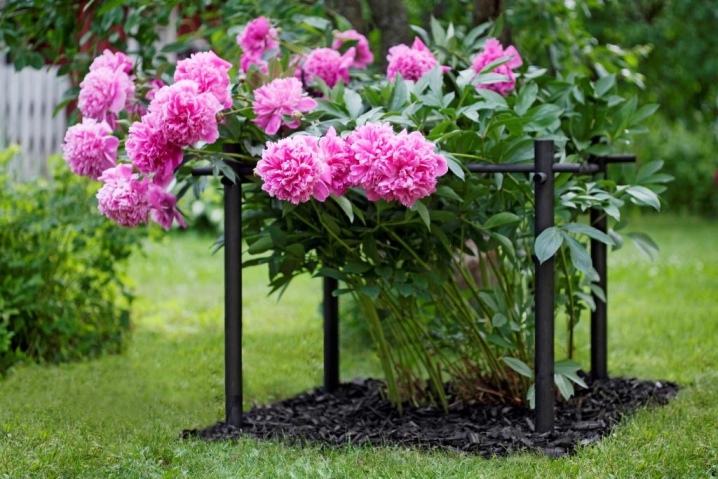
Rejuvenation is a procedure that is recommended to be performed every 5-7 years. Peonies rejuvenate by dividing the bush, which is performed at the end of summer or with the arrival of autumn.
Also, caring for peonies also provides for such procedures that have a beneficial effect on the appearance of buds and flowers. If the plant has formed too many buds, it is better to donate some of them, gardeners say. Otherwise, it can drain the bush.
In order to form large flowers on the plant, it is recommended to remove the smaller lateral buds. Leaving only the central bud on each peduncle, you can achieve full and high-quality flowering without sacrificing the peony itself.
It is important to remove dried inflorescences in a timely manner. They not only give the plant an unkempt appearance, but also significantly increase the risk of pest damage.

Preparing for winter
One of the mandatory procedures that every gardener who grows these beautiful perennials must regularly perform is pre-winter pruning. It should be carried out directly with the arrival of a stable cold snap. During pruning, the aerial part of the plant is removed, leaving only parts of the stems in the root zone at a height of 3-4 centimeters. The cut leaves and shoots are destroyed, and the part remaining above the ground is covered with ash. For the winter, the rest of the bush can be mulched with peat.
However, when mulching peonies, you should perform this procedure so as not to overheat the remnants of the bush.
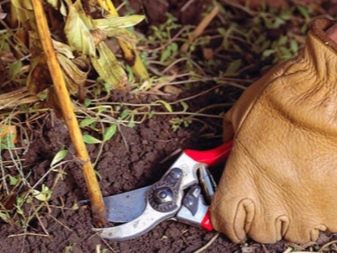
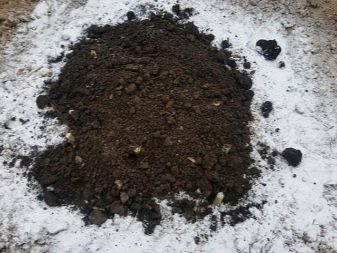
Reproduction
The charm of blooming peonies and their extraordinary aroma are the main arguments in favor of breeding these amazing perennials. One of the most common methods involves plant propagation by dividing the bush. It is advisable to carry out this procedure in late summer - early autumn.
To do this, you must carefully dig up a mature bush, being careful not to damage the roots. Then you should carefully wash off the soil from the roots and leave the plant to dry for several hours. After that, the bush is divided in such a way that on each of the separated parts there are several stems, roots and at least three buds of renewal. All cut sites are treated with ash or crushed coal, and damaged roots are removed. The treated parts of plants are planted in the same way as whole bushes of peonies.

Some growers propagate peonies by seed.In this case, in order to obtain a generation of young plants, the seeds are sown before winter. It must be borne in mind that peonies obtained in this way will bloom only for 4-5 years.
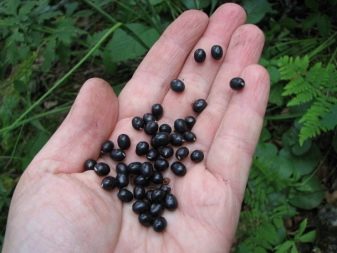

Diseases and pests
According to experienced gardeners, with proper care, these flowering perennials rarely get sick and are affected by pests. However, when grown in open ground conditions, such pests as aphids, thrips, and spider mites can pose a threat to them. You can get rid of them with the help of Fitoverm, Aktara, Aktellik and other insecticides.
Failure to comply with the watering and feeding regime is often the reason for the defeat of peonies by various types of rot (stem, root). It is possible to cope with these diseases through the use of complex fungicidal preparations.
Preventing the development of fungal diseases in the future will allow preventive treatments of plants and adherence to all recommendations for their care.

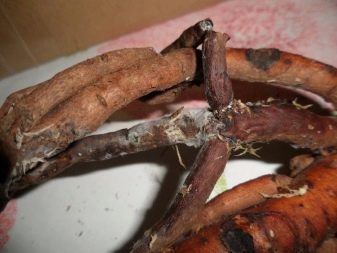
For more on grassy peonies, see the next video.







































































































The comment was sent successfully.